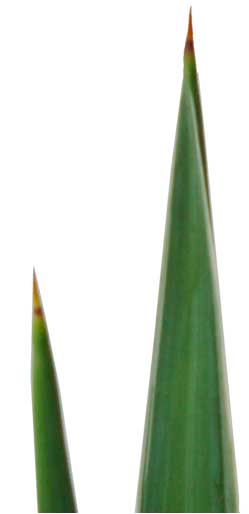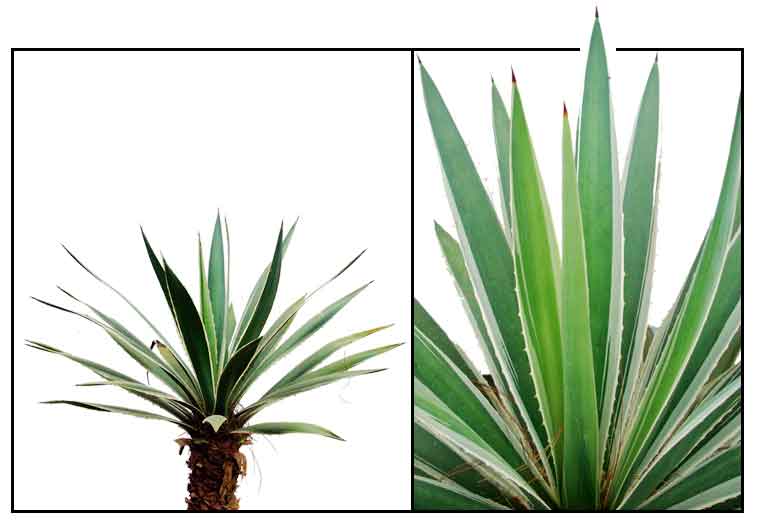 Taxon conflicts Taxon conflicts
The confusion of Agave vivipara L. and A. angustifolia Haw., two distinct taxa . . . The present paper was motivated by a publication of Wijnands (1983), in which his treatment of Agave angustifolia is completely different from our concept of the species. The economic importance of A. angustifolia makes it essential that its taxonomy and nomenclature be set straight.
Wijnands (1983) lectotypified Agave vivipara L. and relegated Agave angustifolia Haw. to synonymy. Even though he cited Trelease (1913), Berger (1915), and Hummelinck (1936), he disagreed with these authors' treatments of A. vivipara and A. angustifolia as distinct species. He also chose not to follow Gentry's (1982) account of the Agaves of continental North America, in which A. angustifolia was treated as a distinct species.
We agree with Wijnands' choice of the lectotype of Agave vivipara, namely Commelin's illustration (t. 15, 1703), wrongly cited as t. 65 by Linnaeus (1753) in the protologue; however, we disagree with his treatment of A. angustifolia Haw. as being conspecific with A. vivipara.
(10)
Botany
Agave is an herb with dense rosette
of sword-shaped, stiff and straight grayish green leaves with sharp-pointed
tips and prickled margins. Some varieties have white-margined leaves.
Distribution
- Native to South America.
-
Introduced to the Philippines during the American period.
- Ornamental cultivation, providing a spiny accent to gardens.
Constituents
- Leaves of these species yield secondary metabolites like fructans and flavonoids, but mainly terpenoids and steroidal saponins. Roots are considered diuretic
and diaphoretic. (5)
- Study yielded two steroidal saponins with the structures of hecogenin oligosaccharides from the saponin fraction. (8)
Properties
- Roots are considered diuretic
and diaphoretic.
- Considered anti-inflammatory,
Parts utilized
Leaves, roots, stems.
Uses
Folkloric
- No known folkloric use
in the Philippines.
- In India,
fresh juice of leaves applied externally to bruises.
- Juice of cooked leaves and stems and a root infusion are taken internally or used as poultices for bruises, internal and external swelling, arthritis, and dysentery.
- In Ayurveda, used as diuretic and expelling kidney stones.
- In Mexican traditional medicine, used to treat inflammation associated conditions. Sap used for treatment of digestive troubles. Also, as remedy for sprains and fractures in both people and animals. (5)
Others
• Agave Nectar is a blend of two agave varieties: A salmiana and
A. angustifolia.
Studies
• While mention is made on the confusion regarding the taxa of A. angustifolia and A. vivipara, this section will continue to include studies and readings attributed to both A. angustifolia and A. vivipara.
• Studied as alternative gene pools to preserve Agave germplasm
diversity for the production of traditional Agave spirits. source
• Mezcal:
Study of five agave plants used in Mexico for mezcal production yielded
sixteen fatty acids, including capric and lignoceric. Lipids included
free fatty acids, ß-sitosterol and groups of mono-, di-, and triacylglycerols. (1)
• Prebiotic / Fructans / Anti-Cancer:
Study evaluated the fermentation properties and potential prebiotic activity of branched fructans derived from Agave angustifolia in a SHIME model. Agave fructans showed prebiotic activity, particularly in relation to colon health in its positive influence on gut barrier function, an important aspect of colon carcinogenesis. (3)
• Anti-Urolithiatic:
Study evaluated the anti-urolithiatic activity of extracts of Agave angustifolia in experimentally induced urolithiatic rats. Results confirmed the beneficial effects in urolithiasis. Administration of aqueous extract and ethanol extracts of Agave angustifolia enhanced extraction of biochemical parameters (sodium, potassium, oxalate, chlorides, calcium), decreasing their levels in the blood, and also decreasing urinary level of uric acid. (4)
• Anti-Inflammatory:
Study evaluated the anti-inflammatory effect of three species of agave genus—A. americana, A. tequilana and A. angustifolia in auricular edema induced TPA model. Results showed a significant decrease of edema caused by TPA. (5)
• Antibacterial: Ethyl acetate extract (EAE) of Agave angustifolia exhibited strongest activities against S. aureus, S. pneumoniae, B. cereus, P. aeruginosa and S. typhi. (6)
• Confusion of A. angustifolia and A. vivipara / Two different Taxa: Paper presents a position that A. angustifolia and A. vivipara are two different taxa. The economic importance of A. angustifolia makes it essential that its taxonomy and nomenclature be set straight. (7)
• Taxa Confusion: There has been considerable confusion over this name. We have followed the treatment of Garcia-Mendoza and Chiang (Brittonia Vol 55 No.1 pp82-87. 2003)[662] who treat this as a distinct species, separate from A. Vivipara and with a distinct range.(9)
Availability
- Wildcrafted.
- Commerce: Agave Nectar, a low-glycemic sweetener, is a blend of two
varieties: Agave salmiana and Agave angustifolia.
|


 Taxon conflicts
Taxon conflicts

